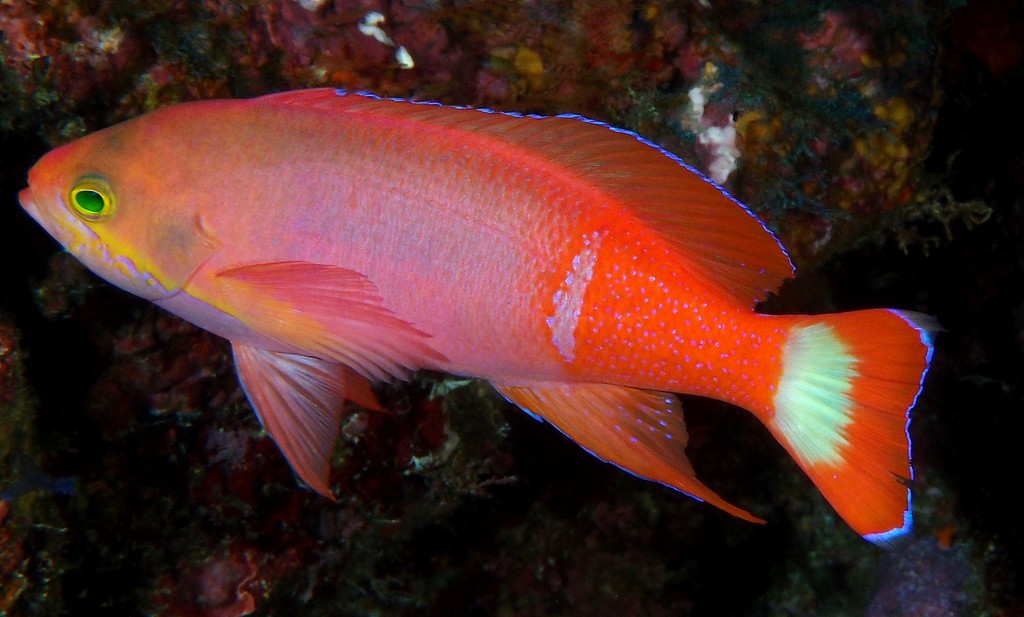PSEUDANTHIAS PICTILIS - (RANDALL & ALLEN, 1978)
Actinopterygii (Gigaclass) > Actinopteri (Class) > Teleostei (Subclass) > Perciformes (Order) > Percoidei (Suborder) > Anthiadidae (Family) > Pseudanthias (Genus)
Anthias pictilis, Anthias brodé, Painted anthias, Painted basslet, Painted goldie, Purple-yellow basslet, Purple-yellow seaperch, 绣花鮨, 锈色拟花鮨, 鏽色擬花鮨,
Synonyme
Anthias pictilis (Randall & Allen, 1978)
------------------------
Description
Dorsal spines (total): 10; Dorsal soft rays (total): 15-16 (rarely: 15); Anal spines: 3; Anal soft rays: 7; Pectoral rays: 18-19; Lateral-line scales: 46-50; Auxiliary scales on head and anterior body; Body depth: 2.9-3.2 in SL. First and tenth dorsa spines longest, but not prolonged. Space between first two dorsal spines narrow. Caudal fin emarginate. Max. length: 13.5 cm TL. Depth range: 12 - 40 m, usually: 20 - 30 m.
Color
Females are fuschia changing to yellow on the rear of the body, and yellowish fins.
Males are mostly fuschia-colored with a broad paler vertical band from the soft dorsal-fin base to the anal-fin base, a yellowish head, red dorsal, anal and pelvic fins, and the caudal fin with a large yellowish patch on the base, and a white fin margin with purplish tips.
Etymology
Pseudanthias: from Greek, pseudes = false + from Greek, anthias = a name of an unknow fish given by Aristotle in "History of Animals". This book, written in the fourth century BC, is one of the major texts on biology by the ancient Greek philosopher Aristotle (384–322 BC), who had studied at Plato's Academy in Athens.
pictilis: from Latin, pictus = painted + from Latin suffix, -ilis or -ālis = used to form adjectives of relationship from nouns or numerals. Here the name meaning, embroider.
Original description: Anthias pictilis Randall & Allen, 1978 - Type locality: southeastern side of North Rock, Lord Howe Island, depth 25-30.5 m.
Distribution
South Pacific: Middleton Reef (Australia), Lord Howe Island, Norfolk Island, New Caledonia, Tonga.
Biology
Occurs in aggregations above steep outer reef slopes. Found in aggregations in the water column above outer reef slopes. Species of Pseudanthias are protogynous hermaphodites, meaning that they can change sex from female to male. They form small haremic groups with a dominant male and several females. Pelagic spawner with pelagic eggs and larvae. Feeds on zooplankton in the water column.
Anthias pictilis, Anthias brodé, Painted anthias, Painted basslet, Painted goldie, Purple-yellow basslet, Purple-yellow seaperch, 绣花鮨, 锈色拟花鮨, 鏽色擬花鮨,
Synonyme
Anthias pictilis (Randall & Allen, 1978)
------------------------
Description
Dorsal spines (total): 10; Dorsal soft rays (total): 15-16 (rarely: 15); Anal spines: 3; Anal soft rays: 7; Pectoral rays: 18-19; Lateral-line scales: 46-50; Auxiliary scales on head and anterior body; Body depth: 2.9-3.2 in SL. First and tenth dorsa spines longest, but not prolonged. Space between first two dorsal spines narrow. Caudal fin emarginate. Max. length: 13.5 cm TL. Depth range: 12 - 40 m, usually: 20 - 30 m.
Color
Females are fuschia changing to yellow on the rear of the body, and yellowish fins.
Males are mostly fuschia-colored with a broad paler vertical band from the soft dorsal-fin base to the anal-fin base, a yellowish head, red dorsal, anal and pelvic fins, and the caudal fin with a large yellowish patch on the base, and a white fin margin with purplish tips.
Etymology
Pseudanthias: from Greek, pseudes = false + from Greek, anthias = a name of an unknow fish given by Aristotle in "History of Animals". This book, written in the fourth century BC, is one of the major texts on biology by the ancient Greek philosopher Aristotle (384–322 BC), who had studied at Plato's Academy in Athens.
pictilis: from Latin, pictus = painted + from Latin suffix, -ilis or -ālis = used to form adjectives of relationship from nouns or numerals. Here the name meaning, embroider.
Original description: Anthias pictilis Randall & Allen, 1978 - Type locality: southeastern side of North Rock, Lord Howe Island, depth 25-30.5 m.
Distribution
South Pacific: Middleton Reef (Australia), Lord Howe Island, Norfolk Island, New Caledonia, Tonga.
Biology
Occurs in aggregations above steep outer reef slopes. Found in aggregations in the water column above outer reef slopes. Species of Pseudanthias are protogynous hermaphodites, meaning that they can change sex from female to male. They form small haremic groups with a dominant male and several females. Pelagic spawner with pelagic eggs and larvae. Feeds on zooplankton in the water column.
Similar species
Pseudanthias bimaculatus (Smith, 1955) - Reported from Indo-West Pacific: East Africa, Aldabra, Madagascar, Réunion (Mascarenes), Maldives, Indonesia, New Caledonia (Report from New Caledonia must be confirmed); Probably more widespread.
Pseudanthias bimaculatus (Smith, 1955) - Reported from Indo-West Pacific: East Africa, Aldabra, Madagascar, Réunion (Mascarenes), Maldives, Indonesia, New Caledonia (Report from New Caledonia must be confirmed); Probably more widespread.
Last update: 3, September 2022
